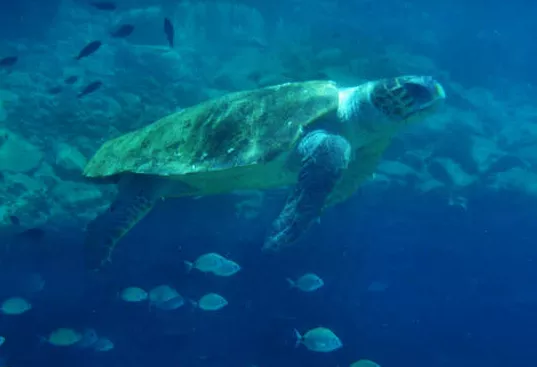Crete, the largest of the Greek islands, is renowned for its stunning landscapes, rich history, and vibrant culture. Yet, beneath its crystal-clear waters lies another world waiting to be explored. Crete’s marine life is as diverse and captivating as its terrestrial beauty, offering a paradise for diving and snorkeling enthusiasts. From colorful reefs and ancient shipwrecks to a plethora of marine species, the island’s underwater treasures provide unforgettable experiences for both novice and experienced divers. This guide highlights some of the best diving and snorkeling hotspots in Crete.
The Beauty Beneath: Why Crete?
1. Pristine Waters: Crete is surrounded by the Mediterranean Sea, known for its clear, warm waters and excellent visibility, often reaching up to 30 meters. This makes it ideal for underwater exploration.
2. Rich Marine Biodiversity: The island’s waters are home to a variety of marine life, including vibrant fish species, sea turtles, octopuses, and even monk seals. The diverse marine ecosystem offers something for everyone, from colorful coral gardens to intriguing underwater caves.
3. Historical Shipwrecks: Crete’s strategic location in the Mediterranean has led to a rich maritime history. Numerous shipwrecks, dating from ancient times to World War II, lie in its waters, providing fascinating dive sites.
Top Diving and Snorkeling Spots
4. Elounda: Elounda, located on the northeastern coast, is one of Crete’s premier diving destinations. The area is known for its calm waters, making it perfect for beginners and experienced divers alike.
- Spinalonga Island: The waters around Spinalonga Island are a popular dive site, offering visibility up to 25 meters. Divers can explore the remnants of ancient walls and structures submerged underwater.
- Sunken City of Olous: Off the coast of Elounda lies the ancient sunken city of Olous. Snorkelers and divers can swim among the ruins of this once-thriving city, making it a unique underwater archaeological site.
5. Chania: Chania, on the northwest coast, offers a variety of dive sites, from caves and reefs to shipwrecks.
- Elephant Cave: This spectacular underwater cave is named after the fossilized elephant bones found within. The cave features stunning stalactites and stalagmites, making it a favorite among experienced divers.
- The Minnewaska Shipwreck: This World War II shipwreck lies off the coast of Chania and is one of the most famous dive sites in Crete. The wreck is home to a variety of marine life, including colorful fish and corals.
6. Rethymno: Rethymno, situated on the northern coast, is known for its diverse dive sites and rich marine life.
- The Wall: A popular dive site featuring a dramatic drop-off that descends to over 40 meters. The wall is covered in vibrant corals and sponges, attracting a wide array of fish species.
- Stavros Reef: This reef is perfect for both divers and snorkelers, offering shallow waters teeming with marine life. The reef’s structure creates numerous hiding spots for octopuses, eels, and other sea creatures.
7. Agios Nikolaos: Agios Nikolaos, on the eastern coast, is renowned for its clear waters and beautiful dive sites.
- The Blue Cave: This underwater cave is famous for its stunning blue light, caused by sunlight filtering through the water. Divers can explore the cave’s intricate rock formations and encounter various marine species.
- Voulismeni Lake: Although technically a lake, Voulismeni is connected to the sea and offers a unique diving experience. The lake’s depths reach up to 64 meters, and it is rumored to be bottomless.
Preparing for Your Dive
8. Dive Centers and Schools: Crete is home to numerous dive centers and schools that cater to all skill levels. These centers offer a range of services, from equipment rental and guided dives to certification courses. Some of the most reputable dive centers include Blue Dolphin Diving Center in Elounda, Omega Divers in Chania, and Atlantis Diving Center in Rethymno.
9. Safety First: Always prioritize safety when diving or snorkeling. Ensure your equipment is in good condition, follow local regulations, and never dive alone. For those new to diving, taking a certification course from a recognized dive school is highly recommended.
10. Respect Marine Life: While exploring Crete’s underwater world, remember to respect the marine environment. Avoid touching or disturbing marine life, and be mindful of your surroundings to prevent damage to fragile ecosystems.
When to Dive
11. Best Time to Visit: The best time for diving and snorkeling in Crete is between May and October, when the water temperatures range from 20°C to 26°C (68°F to 79°F). During these months, the sea is calm, and visibility is at its best.
Conclusion
Crete’s marine life and underwater landscapes offer a captivating experience for diving and snorkeling enthusiasts. From the ancient ruins of Olous and the mystical Elephant Cave to the vibrant reefs and historical shipwrecks, the island’s waters are teeming with wonders waiting to be explored. Whether you are a seasoned diver or a beginner looking to dip your toes into the world of underwater exploration, Crete provides the perfect setting for an unforgettable adventure. Embrace the opportunity to discover the hidden treasures beneath the surface and immerse yourself in the rich marine life that makes Crete a premier diving destination.


